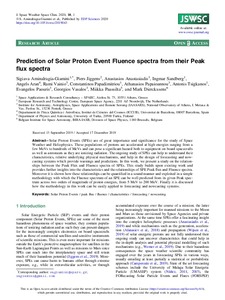Prediction of Solar Proton Event Fluence spectra from their Peak flux spectra
Aminalragia-Giamini S; Jiggens P; Anastasiadis A; Sandberg I; Aran A; Vainio R; Papadimitriou C; Papaioannou A; Tsigkanos A; Paouris E; Vasalos G; Paassilta M; Dierckxsens M
Prediction of Solar Proton Event Fluence spectra from their Peak flux spectra
Aminalragia-Giamini S
Jiggens P
Anastasiadis A
Sandberg I
Aran A
Vainio R
Papadimitriou C
Papaioannou A
Tsigkanos A
Paouris E
Vasalos G
Paassilta M
Dierckxsens M
EDP SCIENCES S A
Julkaisun pysyvä osoite on:
https://urn.fi/URN:NBN:fi-fe2021042821054
https://urn.fi/URN:NBN:fi-fe2021042821054
Tiivistelmä
Solar Proton Events (SPEs) are of great importance and significance for the study of Space Weather and Heliophysics. These populations of protons are accelerated at high energies ranging from a few MeVs to hundreds of MeVs and can pose a significant hazard both to equipment on board spacecrafts as well as astronauts as they are ionizing radiation. The ongoing study of SPEs can help to understand their characteristics, relative underlying physical mechanisms, and help in the design of forecasting and nowcasting systems which provide warnings and predictions. In this work, we present a study on the relationships between the Peak Flux and Fluence spectra of SPEs. This study builds upon existing work and provides further insights into the characteristics and the relationships of SPE Peak flux and Fluence spectra. Moreover it is shown how these relationships can be quantified in a sound manner and exploited in a simple methodology with which the Fluence spectrum of an SPE can be well predicted from its given Peak spectrum across two orders of magnitude of proton energies, from 5 MeV to 200 MeV. Finally it is discussed how the methodology in this work can be easily applied to forecasting and nowcasting systems.
Kokoelmat
- Rinnakkaistallenteet [27094]
